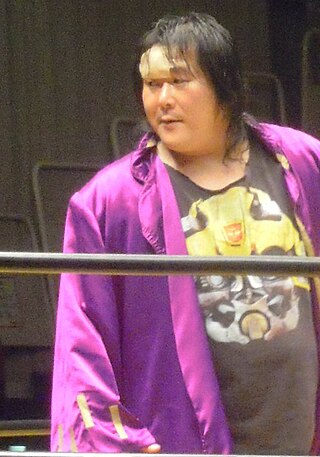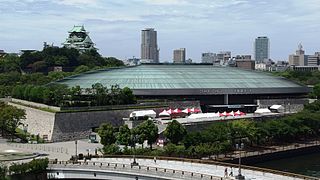
Michael Lee Alfonso was an American professional wrestler. He was best known for his appearances with the American professional wrestling promotions Extreme Championship Wrestling (ECW), World Championship Wrestling (WCW) and the World Wrestling Federation/Entertainment (WWF/E) under the ring name Mike Awesome and for his appearances in Japan with Frontier Martial-Arts Wrestling and All Japan Pro Wrestling as The Gladiator.

Atsushi Onita is a Japanese actor, politician, and semi-retired professional wrestler. He is best known for his work in Frontier Martial-Arts Wrestling (FMW) and is credited with introducing the deathmatch style of professional wrestling to Japan. He is a former All Asia Tag Team Champions alongside Yoshitatsu.
The FMW Independent Heavyweight Championship was a professional wrestling world heavyweight championship contested in Frontier Martial-Arts Wrestling (FMW). It was one of the top two titles in the company, along with the FMW Brass Knuckles Heavyweight Championship. The title belt was created for Atsushi Onita to use in his retirement match at 6th Anniversary Show in 1995 but could not be shipped to FMW at that time and the title was finally shipped to FMW in 1996 and FMW used it as the alternative top title to the Brass Knuckles Heavyweight Championship. Both titles were unified later that year and were collectively referred to as "FMW Double Championship". The titles were separated in 1999 and deactivated later that year in favor of the new WEW Single Championship.

Yukihiro Kanemura, better known by his ring name Kintaro Kanemura, is a Zainichi Korean retired professional wrestler. He also wrestled under the ring name Wing Kanemura. He is best known for his death matches in Apache Army, Big Japan Pro Wrestling (BJW), Extreme Championship Wrestling (ECW), Frontier Martial-Arts Wrestling (FMW), International Wrestling Association (IWA) and Wrestling International New Generations (W*ING).
Koji Nakagawa is a Japanese semi-retired professional wrestler best known for his work in Frontier Martial-Arts Wrestling (FMW) between 1992 and 2002. He is perhaps best known for his “Hitman” character, heavily inspired by Canadian professional wrestler Bret Hart. Nakagawa also wrestled as Goemon between 2000 and 2002, a dark thief character that was eventually killed and turned into a ghost in storyline.

FMW 1st Anniversary Show was the first professional wrestling supercard produced by the Japanese professional wrestling promotion Frontier Martial-Arts Wrestling (FMW). The event took place on November 5, 1990 at the Komazawa Gymnasium in Tokyo, Japan and was held to celebrate the first anniversary of FMW, which was founded on July 28, 1989. This was the first edition of the Anniversary Show, FMW's biggest event of the year.
The W*ING Alliance was a Japanese professional wrestling group that existed in Frontier Martial-Arts Wrestling (FMW) between 1994 and 1997. The group consisted of wrestlers from the W*ING promotion, which ended in March 1994 due to FMW hiring the top tier talent of W*ING and the W*ING alumni wanted to avenge the demise of the company from FMW and the company's owner Atsushi Onita in storyline.

FMW 6th Anniversary Show was a professional wrestling event produced by Frontier Martial-Arts Wrestling (FMW), taking place on May 5, 1995 at the Kawasaki Stadium in Kawasaki, Kanagawa, Japan. This was the sixth edition of the company's flagship event Anniversary Show, commemorating the sixth anniversary of the company and the third consecutive and fourth overall edition of Anniversary Show at Kawasaki Stadium.

FMW 7th Anniversary Show was a professional wrestling event produced by Frontier Martial-Arts Wrestling (FMW), taking place on May 5, 1996 at the Kawasaki Stadium in Kawasaki, Kanagawa, Japan. This was the seventh edition of the company's flagship event Anniversary Show, commemorating the seventh anniversary of the company and the fourth consecutive and fifth overall edition of Anniversary Show at Kawasaki Stadium.

ZEN was a professional wrestling stable in Frontier Martial-Arts Wrestling (FMW). The group was led by former FMW owner and the company's founder Atsushi Onita from late 1997 to mid 1998 and the group was based on World Championship Wrestling's New World Order (nWo). The group produced its own shows in collaboration with FMW like nWo promoted its own pay-per-view nWo Souled Out.
Team No Respect was a professional wrestling faction in Frontier Martial-Arts Wrestling (FMW), which existed in the company between 1998 and 2000. The ideology of the group was that they disrespected all the wrestlers in FMW as well as the company's management and President Shoichi Arai. TNR was formed after Mr. Gannosuke, Yukihiro Kanemura and Hido turned on their ZEN leader Atsushi Onita out of jealousy with Onita due to his high ego and selfishness and formed a major alliance with Fuyuki-Gun. TNR was the most popular, successful and influential stable in the history of FMW and were involved in FMW's major storylines and rivalries during its two and a half year existence.

Hideo Takayama was a Japanese professional wrestler, better known under the ring name BADBOY Hido or simply Hido. He is best known for his time with hardcore wrestling federations Big Japan Pro Wrestling (BJW), Independent Wrestling Association Mid-South (IWA-MS), Frontier Martial-Arts Wrestling (FMW) and Wrestling International New Generations (W*ING).
Super Extreme Wrestling War was a series of professional wrestling events produced by Frontier Martial-Arts Wrestling (FMW) in 1997. These events marked the first time that FMW began a partnership with American counterpart Extreme Championship Wrestling (ECW) and a working relationship began between the two companies as ECW wrestlers competed at these events and it marked the beginning of interpromotional matches and events between ECW and FMW. These events would create a huge impact in FMW's storylines as they concluded with the breakup of ZEN when Mr. Gannosuke, Yukihiro Kanemura and Hido attacked their leader Atsushi Onita out of jealousy after Hayabusa pinned Onita in a WarGames match. They merged with Fuyuki-Gun to form Team No Respect, which would dominate FMW until 2000.
Year End Spectacular (1993) was a major professional wrestling event produced by Frontier Martial-Arts Wrestling (FMW). The event took place on December 8, 1993 at the Tokyo International Trade Harumi Dome in Tokyo, Japan. This was the first Year End Spectacular event and would set the stage for future major events in FMW to close the month of December.

Year End Spectacular (1996) was the third and final Year End Spectacular professional wrestling event produced by Frontier Martial-Arts Wrestling on December 11, 1996. The event was a part of the 1996 Year End Sensation tour, which concluded with the Year End Spectacular event.

Summer Spectacular (1994) was the third Summer Spectacular professional wrestling event produced by Frontier Martial-Arts Wrestling (FMW). The event took place on August 28, 1994 at the Osaka-jō Hall in Osaka, Japan.
Summer Spectacular (1996) was the fourth Summer Spectacular professional wrestling event produced by Frontier Martial-Arts Wrestling (FMW). The event took place on August 1, 1996 at the Shiodome in Tokyo, Japan.

Fall Spectacular: Kawasaki Legend was a Fall Spectacular professional wrestling event produced by Frontier Martial-Arts Wrestling (FMW). The event took place on September 28, 1997 at the Kawasaki Stadium in Kawasaki, Kanagawa, Japan. The show aired via tape delay on Samurai TV! on October 12.

Katsuji Ueda was a Japanese kickboxer, martial artist and professional wrestler, best known for his time with Frontier Martial-Arts Wrestling (FMW) between 1990 and 1995. He was usually utilized in martial arts fights during his FMW career and won the promotion's World Light Heavyweight Championship three times. He was also a bodyguard for Atsushi Onita.
Mitsuhiro Matsunaga is a Japanese retired professional wrestler best known for his deathmatch wrestling style, having competed in memorable deathmatches in Big Japan Pro Wrestling (BJW), Frontier Martial-Arts Wrestling (FMW) and Wrestling International New Generations (W*ING). He is renowned for participating in the first-ever deathmatch in Japanese wrestling history on December 10, 1989 and is also credited for participating in a Piranha Deathmatch against Kendo Nagasaki on August 19, 1996, which has been considered to be the most popular and greatest deathmatch in Japanese wrestling history by wrestling journalists and many sports websites and Matsunaga has received critical acclaim for his performance.








